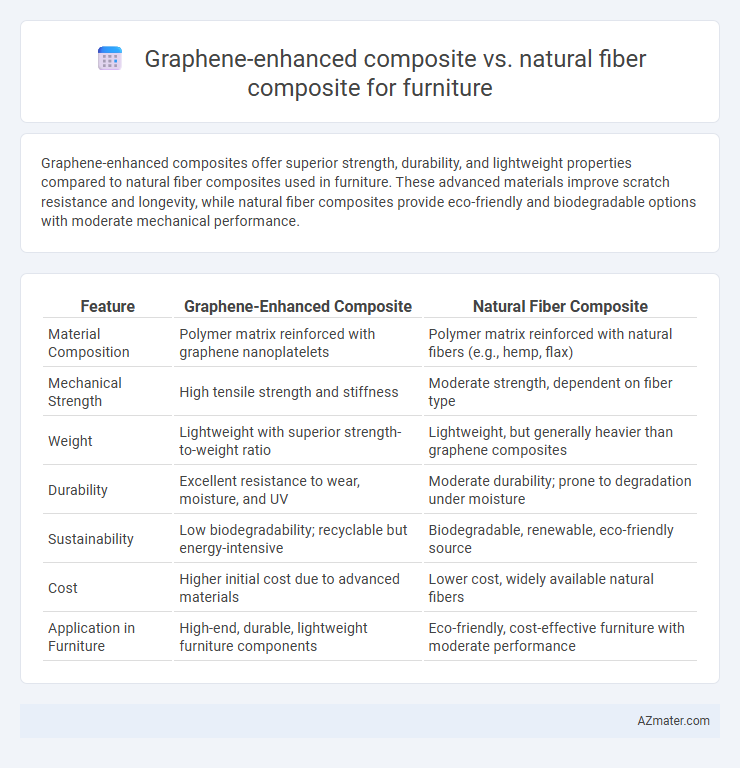Graphene-enhanced composites offer superior strength, durability, and lightweight properties compared to natural fiber composites used in furniture. These advanced materials improve scratch resistance and longevity, while natural fiber composites provide eco-friendly and biodegradable options with moderate mechanical performance.
Table of Comparison
| Feature | Graphene-Enhanced Composite | Natural Fiber Composite |
|---|---|---|
| Material Composition | Polymer matrix reinforced with graphene nanoplatelets | Polymer matrix reinforced with natural fibers (e.g., hemp, flax) |
| Mechanical Strength | High tensile strength and stiffness | Moderate strength, dependent on fiber type |
| Weight | Lightweight with superior strength-to-weight ratio | Lightweight, but generally heavier than graphene composites |
| Durability | Excellent resistance to wear, moisture, and UV | Moderate durability; prone to degradation under moisture |
| Sustainability | Low biodegradability; recyclable but energy-intensive | Biodegradable, renewable, eco-friendly source |
| Cost | Higher initial cost due to advanced materials | Lower cost, widely available natural fibers |
| Application in Furniture | High-end, durable, lightweight furniture components | Eco-friendly, cost-effective furniture with moderate performance |
Introduction to Advanced Composite Materials in Furniture
Graphene-enhanced composites in furniture offer superior strength-to-weight ratios, exceptional durability, and enhanced resistance to wear compared to natural fiber composites, which provide eco-friendly advantages such as biodegradability and renewable sourcing. Advanced composite materials incorporating graphene deliver improved mechanical performance and longer lifecycle, making them ideal for high-end, load-bearing furniture applications. Natural fiber composites remain preferred for sustainable furniture designs due to their lower environmental impact and natural aesthetic appeal.
Overview of Graphene-Enhanced Composites
Graphene-enhanced composites incorporate graphene nanoplatelets into polymer matrices, significantly improving mechanical strength, thermal conductivity, and durability compared to traditional materials. These composites offer superior resistance to wear and environmental degradation, making them highly suitable for high-performance furniture applications. Their lightweight nature combined with exceptional stiffness also provides enhanced design flexibility without compromising structural integrity.
Natural Fiber Composites: Types and Applications
Natural fiber composites for furniture primarily use fibers such as jute, hemp, flax, and sisal, which provide sustainability and biodegradability advantages. These composites offer lightweight properties, improved thermal insulation, and cost-effectiveness, making them ideal for eco-friendly furniture manufacturing. Applications extend to chairs, tables, and cabinetry where strength and aesthetics benefit from the natural texture and environmental impact reduction.
Mechanical Strength Comparison
Graphene-enhanced composites exhibit significantly higher mechanical strength compared to natural fiber composites, with tensile strength improvements reaching up to 200% due to graphene's exceptional stiffness and load transfer capabilities. Natural fiber composites offer moderate strength with advantages in sustainability and cost-effectiveness but generally lack the superior durability and impact resistance provided by graphene reinforcement. The integration of graphene enables furniture materials to withstand greater mechanical stresses, offering enhanced longevity and performance in high-load applications.
Weight and Density Differences
Graphene-enhanced composites exhibit significantly lower density compared to natural fiber composites, resulting in lighter furniture without compromising structural integrity. The exceptional strength-to-weight ratio of graphene allows for thinner, more durable furniture designs, while natural fibers tend to increase overall weight due to their higher density and moisture absorption properties. This weight reduction enhances portability and ease of handling, making graphene-based composites preferable for modern lightweight furniture applications.
Environmental Impact and Sustainability
Graphene-enhanced composites in furniture manufacturing offer superior strength-to-weight ratios and durability, significantly extending product lifespan and reducing resource consumption. Natural fiber composites, derived from renewable resources such as flax, hemp, or jute, provide a biodegradable alternative with lower carbon footprints and reduced reliance on synthetic materials. While graphene composites often involve energy-intensive production processes, natural fiber composites excel in biodegradability and end-of-life recyclability, positioning them as more sustainable options in environmentally conscious furniture design.
Cost Analysis for Furniture Manufacturing
Graphene-enhanced composites offer superior strength and durability but come with significantly higher material costs compared to natural fiber composites, impacting overall furniture manufacturing expenses. Natural fiber composites provide a cost-effective alternative with lower raw material prices and reduced processing energy, making them attractive for budget-conscious production. Manufacturers must weigh the premium of graphene materials against long-term durability benefits when analyzing total cost of ownership in furniture applications.
Design Flexibility and Aesthetic Potential
Graphene-enhanced composites offer superior design flexibility due to their lightweight nature and exceptional strength, enabling thinner, more intricate furniture shapes without compromising durability. Natural fiber composites provide a warm, organic aesthetic that appeals to eco-friendly consumers but are often limited in form complexity due to material constraints. The combination of graphene's mechanical properties with natural fibers could potentially unlock new aesthetic possibilities and more versatile furniture designs.
Durability and Longevity in Real-world Use
Graphene-enhanced composites offer superior durability and longevity compared to natural fiber composites in furniture applications due to their exceptional tensile strength and resistance to wear, moisture, and UV degradation. Natural fiber composites, while eco-friendly and lightweight, tend to absorb moisture leading to swelling, fungal growth, and reduced structural integrity over time. Real-world use demonstrates that graphene-enhanced furniture maintains performance under heavy use and harsh conditions, significantly extending product lifespan.
Future Trends in Composite Furniture Materials
Graphene-enhanced composites exhibit superior mechanical strength, electrical conductivity, and durability compared to natural fiber composites, making them ideal for futuristic furniture designs emphasizing performance and smart functionality. Future trends in composite furniture materials highlight increased integration of graphene to enable lightweight structures with enhanced wear resistance and embedded sensor capabilities, surpassing the environmental benefits of natural fibers. Innovations in manufacturing techniques such as 3D printing and nanotechnology will accelerate the adoption of graphene composites in sustainable, high-performance furniture solutions.

Infographic: Graphene-enhanced composite vs Natural fiber composite for Furniture
 azmater.com
azmater.com